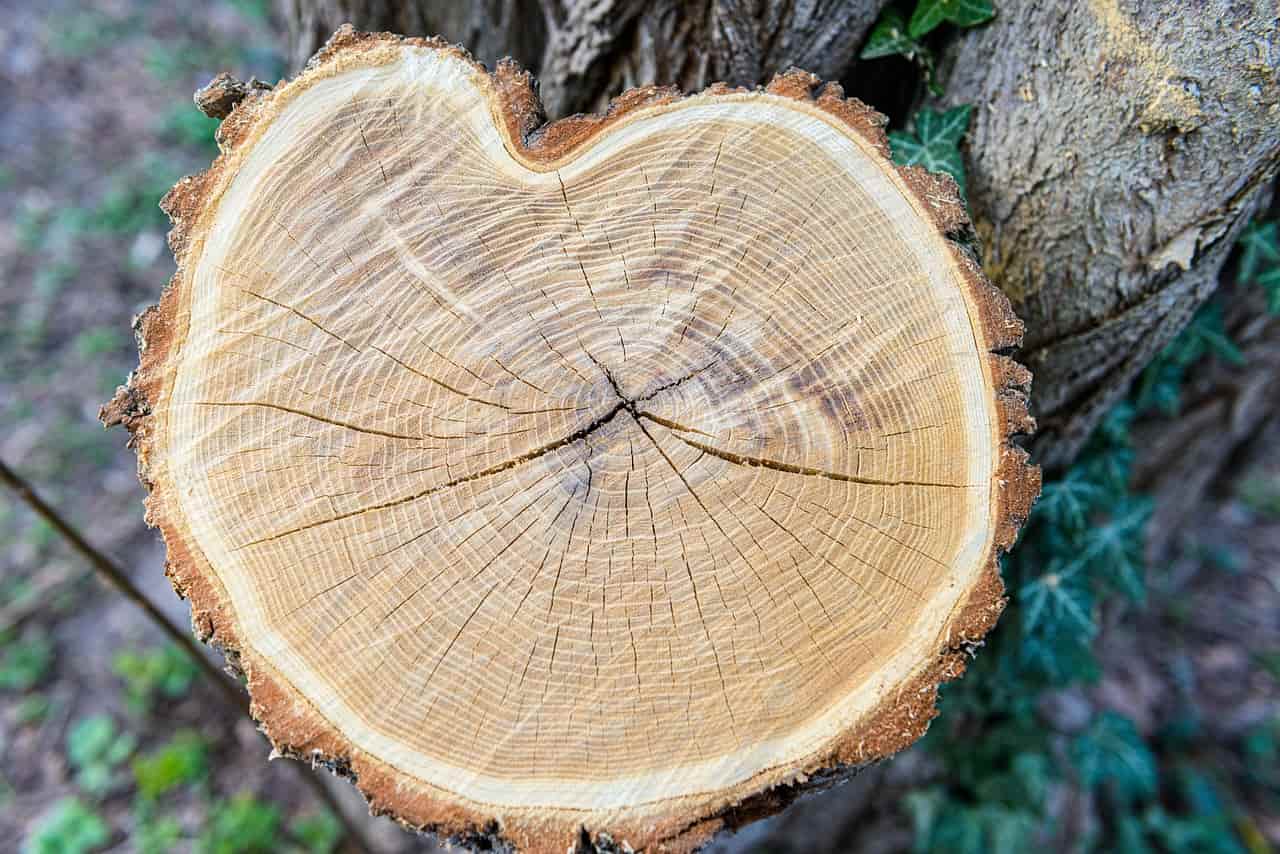After tree removal, many homeowners are left with an unsightly tree stump that seems harmless enough to leave behind.
However, ignoring that leftover reminder of your once-towering tree can lead to numerous problems that affect your property’s safety, health, and value.
Understanding the risks associated with dangerous tree stumps can help property owners make informed decisions about proper yard cleanup and maintenance.
WHAT HAPPENS TO A TREE STUMP AFTER TREE REMOVAL
When a tree is cut down, the remaining stump doesn’t simply disappear on its own. Instead, it begins a slow process of stump decay that can take years or even decades to complete naturally.
During this time, the dead wood becomes a breeding ground for various organisms and creates multiple hazards for homeowners.
The stump rot problems begin almost immediately after tree removal. As moisture penetrates the dead wood, it creates ideal conditions for fungal growth and bacterial decomposition.
This process attracts various pests and creates an environment where tree stump disease can occur, potentially affecting nearby healthy vegetation.
The root system interference continues even after the visible tree is gone. Underground roots can remain active for months, sometimes causing regrowth from a tree stump as new shoots emerge from the remaining root network.
These leftover tree roots can extend far beyond the visible stump, creating ongoing complications for landscaping and lawn maintenance.
WHY YOU SHOULDN’T LEAVE A TREE STUMP IN THE GROUND
Property Damage
One of the most significant concerns with abandoned tree stumps involves potential property damage. The stump-damaging lawn growth occurs as the decaying wood releases chemicals that can inhibit grass and plant growth in surrounding areas.
This creates dead zones in otherwise healthy lawns, affecting the overall landscape improvement efforts.
More seriously, stumps can pose an insurance risk for property owners. If someone is injured on the property due to a trip hazard in the yard caused by an overlooked stump, homeowners may face liability issues.
This insurance risk tree stump situation becomes particularly concerning when the stump is located in high-traffic areas or along walkways.
The impact on real estate and tree stumps cannot be overlooked either. Potential buyers often view neglected stumps as signs of poor property maintenance, which can negatively affect property value.
An ugly stump in the front yard creates an immediate negative first impression that can influence a buyer’s perception of the entire property.
Fire Ants and Other Unwanted Guests
Tree stumps create perfect habitats for various unwanted visitors. Pest infestations in tree stumps are incredibly common, with multiple species finding the decaying wood an ideal place to establish colonies.
Termite attraction to stumps represents one of the most serious concerns, as these destructive insects can eventually migrate from the stump to nearby structures.
Carpenter ants in tree stump colonies are another frequent problem. These insects excavate galleries within the rotting wood, accelerating the decay process while establishing large populations that can spread to healthy trees and wooden structures.
The presence of insects living in stumps creates an ongoing pest management challenge for homeowners.
Beyond insects, stumps attracting rodents is also a common issue. Mice, rats, and other small mammals often use hollow stumps as nesting sites, bringing additional pest problems to the property.
Even wasps in dead tree stump situations occur frequently, as these insects build nests in the protected cavities of decaying wood.
Oak Wilt: A North Texas Nightmare
In regions like North Texas, tree stump disease presents particularly serious concerns. Oak wilt, a devastating fungal disease, can spread through interconnected root systems from infected stumps to healthy oak trees.
This stump fungus risk scenario can lead to the loss of multiple mature trees across a property or even throughout an entire neighborhood.
The tree stump mold problems extend beyond oak wilt as well. Various fungi that develop in decaying stumps can spread to other plants, creating ongoing plant health issues throughout the landscape.
These stump fungus risks make professional removal a wise investment for long-term garden and lawn health.
Tripping Hazards and Liability
Perhaps the most immediate concern for families involves lawn safety and the potential for accidents. Tree stumps create significant trip hazards, particularly for children and elderly visitors who may not notice the obstacle until it’s too late.
The stump danger for children is especially concerning, as kids often run and play without carefully watching the ground ahead.
Pet injury from stumps also occurs frequently, as dogs and cats can easily catch their legs or paws on protruding roots or uneven stump surfaces.
Creating a kid-friendly yard safety environment requires removing these hazards to prevent accidents during normal outdoor activities.
For homeowners who maintain playground areas or entertainment spaces, backyard hazard removal becomes essential for protecting family and guests.
The liability concerns extend beyond immediate family members to include visitors, delivery personnel, and service providers who may access the property.
Stumps Steal Nutrients from Your Lawn
The ongoing stump blocking grass regrowth creates persistent lawn maintenance challenges. Even as the stump slowly decays, it continues to compete with surrounding vegetation for water and nutrients.
This competition often results in thin, patchy grass around the stump area that requires extra fertilization and care.
The tree stumps affecting soil composition also impact the overall health of nearby plants. As the wood decomposes, it can alter soil pH and nutrient levels, creating conditions that may not support healthy lawn growth.
This makes landscape improvement efforts more difficult and expensive over time.
Aesthetics and Space
From a curb appeal perspective, leaving stumps in place significantly impacts the property’s appearance. An unsightly tree stump immediately draws attention and suggests that the property isn’t well-maintained.
This affects not only the homeowner’s enjoyment of their outdoor space but also influences how neighbors and visitors perceive the property.
The space occupied by stumps also limits landscaping options and lawn usage. Areas around stumps become difficult to mow, plant, or utilize for outdoor activities.
This wasted space reduces the functional area of the yard and complicates maintenance routines.
Continued Tree Growth
One of the most surprising issues homeowners face involves stump sprouting problems. Many tree species can produce new growth from remaining root systems, leading to multiple small trees emerging around the original stump location.
These stump replanting issues create ongoing maintenance headaches and can quickly overwhelm the area if not addressed promptly.
The regrowth from tree stump situations often produces weak, multiple-trunked trees that are structurally unsound and prone to storm damage.
Managing this continued growth requires regular cutting and treatment, making the initial stump removal a more cost-effective long-term solution.
WHAT TO DO IF YOU HAVE A TREE STUMP
Fortunately, several options exist for addressing problematic stumps. Stump removal services offer professional solutions that completely eliminate both the visible stump and the root system. These services typically provide the most thorough results and prevent future complications.
For homeowners wondering how to get rid of tree stumps on their own, several DIY options are available. Stump grinder rental allows capable homeowners to tackle the job themselves, though this requires proper safety equipment and some mechanical skill.
The cost to remove a tree stump professionally often proves worthwhile when considering the time, effort, and equipment rental costs involved in DIY approaches.
When comparing stump removal vs stump grinding options, homeowners should consider their specific needs.
Grinding removes the visible portion and several inches of root system, while complete removal eliminates the entire root network.
For most residential situations, professional grinding provides adequate results at a reasonable cost.
Chemical solutions offer another approach for patient homeowners. Tree stump chemical remover products can accelerate the natural decay process, though this method requires months or years to achieve complete results.
For those seeking eco-friendly stump removal options, these chemical treatments often use naturally occurring compounds that break down wood fibers safely.
Some homeowners consider burning a tree stump as a removal method, though this approach requires careful safety precautions and may not be legal in all areas.
Local regulations and fire safety concerns make this option less practical for most urban and suburban properties.
For smaller stumps or those in less critical locations, manual stump removal remains possible with proper tools and techniques. This labor-intensive approach works best for recently removed trees with smaller root systems.
Taking Action for a Safer, More Beautiful Yard
Addressing tree stump hazards promptly protects both property values and family safety. Whether choosing professional removal services or tackling the project independently, eliminating dangerous stumps creates a safer, more attractive outdoor environment that everyone can enjoy.
The investment in proper stump removal pays dividends through improved curb appeal, property value, reduced liability risks, and easier lawn maintenance.
Rather than dealing with ongoing pest problems, safety hazards, and aesthetic issues, homeowners can create clean, functional outdoor spaces that enhance their property’s value and usability.
For properties involved in stump on property line disputes or tree stump neighbor conflicts, addressing the issue promptly often helps maintain good relationships while protecting everyone’s interests.
Professional removal services can often work around property boundaries to solve these situations diplomatically.
Taking action now prevents minor stump problems from becoming major headaches that require more expensive solutions later.
Whether motivated by safety concerns, aesthetic improvements, or property value protection, removing that ignored stump represents a wise investment in your property’s future.

